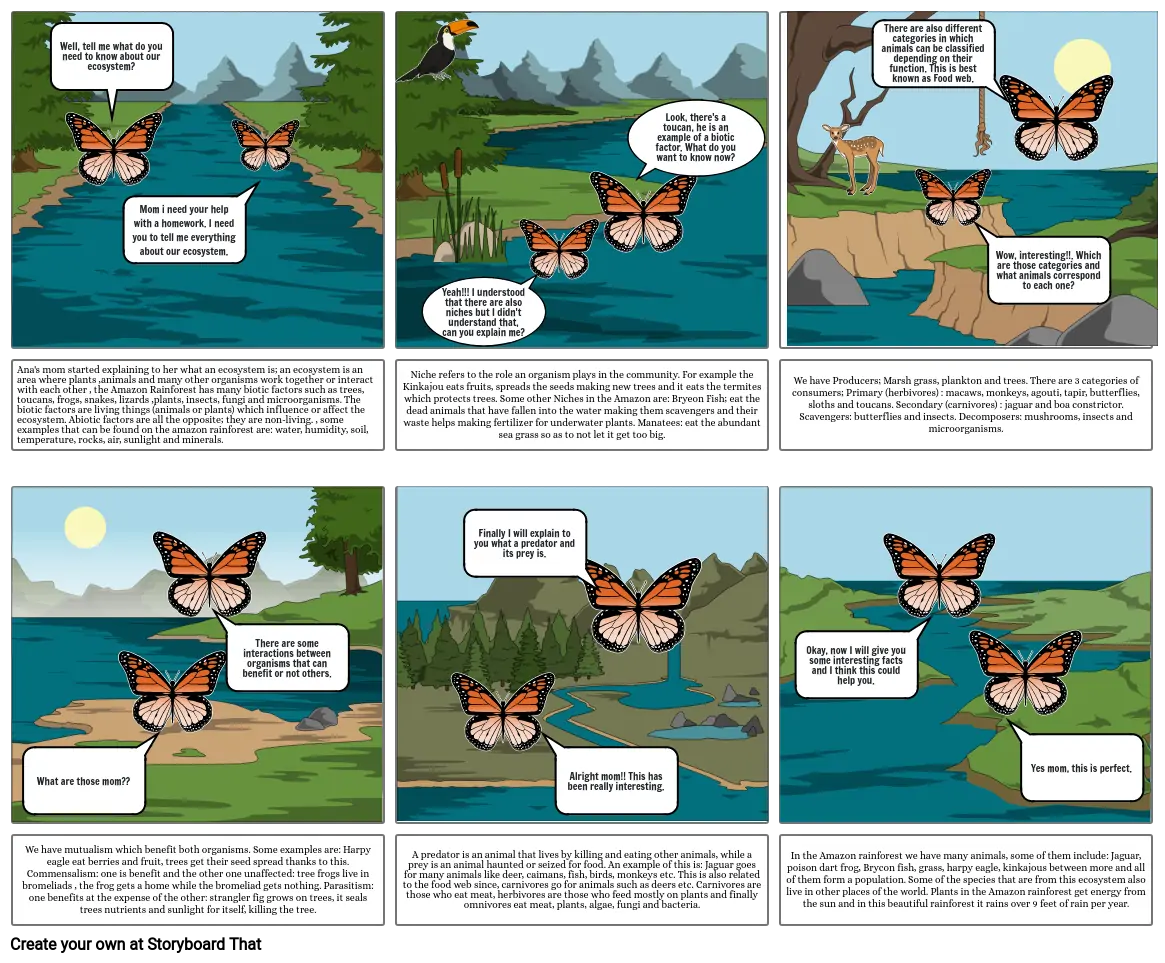Amazon rainforest

Storyboard Text
- Well, tell me what do you need to know about our ecosystem?
- Mom i need your help with a homework. I need you to tell me everything about our ecosystem.
- Yeah!!! I understood that there are also niches but I didn't understand that, can you explain me?
- Look, there's a toucan, he is an example of a biotic factor. What do you want to know now?
- There are also different categories in which animals can be classified depending on their function. This is best known as Food web.
- Wow, interesting!!. Which are those categories and what animals correspond to each one?
- Ana's mom started explaining to her what an ecosystem is; an ecosystem is an area where plants ,animals and many other organisms work together or interact with each other , the Amazon Rainforest has many biotic factors such as trees, toucans, frogs, snakes, lizards ,plants, insects, fungi and microorganisms. The biotic factors are living things (animals or plants) which influence or affect the ecosystem. Abiotic factors are all the opposite; they are non-living. , some examples that can be found on the amazon rainforest are: water, humidity, soil, temperature, rocks, air, sunlight and minerals.
- There are some interactions between organisms that can benefit or not others.
- Niche refers to the role an organism plays in the community. For example the Kinkajou eats fruits, spreads the seeds making new trees and it eats the termites which protects trees. Some other Niches in the Amazon are: Bryeon Fish; eat the dead animals that have fallen into the water making them scavengers and their waste helps making fertilizer for underwater plants. Manatees: eat the abundant sea grass so as to not let it get too big.
- Finally I will explain to you what a predator and its prey is.
- We have Producers; Marsh grass, plankton and trees. There are 3 categories of consumers; Primary (herbivores) : macaws, monkeys, agouti, tapir, butterflies, sloths and toucans. Secondary (carnivores) : jaguar and boa constrictor. Scavengers: butterflies and insects. Decomposers: mushrooms, insects and microorganisms.
- Okay, now I will give you some interesting facts and I think this could help you.
- We have mutualism which benefit both organisms. Some examples are: Harpy eagle eat berries and fruit, trees get their seed spread thanks to this. Commensalism: one is benefit and the other one unaffected: tree frogs live in bromeliads , the frog gets a home while the bromeliad gets nothing. Parasitism: one benefits at the expense of the other: strangler fig grows on trees, it seals trees nutrients and sunlight for itself, killing the tree.
- What are those mom??
- A predator is an animal that lives by killing and eating other animals, while a prey is an animal haunted or seized for food. An example of this is: Jaguar goes for many animals like deer, caimans, fish, birds, monkeys etc. This is also related to the food web since, carnivores go for animals such as deers etc. Carnivores are those who eat meat, herbivores are those who feed mostly on plants and finally omnivores eat meat, plants, algae, fungi and bacteria.
- Alright mom!! This has been really interesting.
- In the Amazon rainforest we have many animals, some of them include: Jaguar, poison dart frog, Brycon fish, grass, harpy eagle, kinkajous between more and all of them form a population. Some of the species that are from this ecosystem also live in other places of the world. Plants in the Amazon rainforest get energy from the sun and in this beautiful rainforest it rains over 9 feet of rain per year.
- Yes mom, this is perfect.
Over 30 Million Storyboards Created

